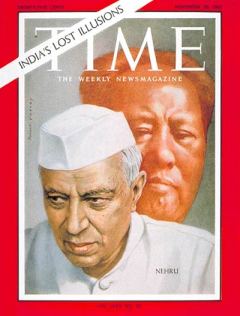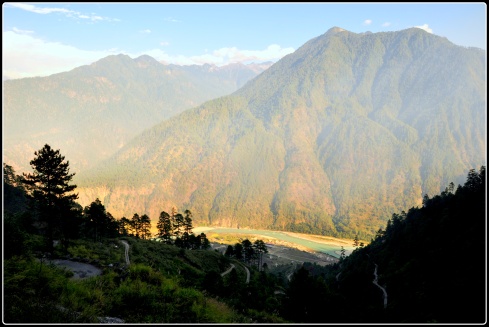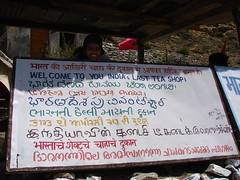Half a century ago, India suffered its worst military attack, and subsequent defeat, throwing open a gaping hole at the border, and proving how unprepared India was, militarily and politically. On the 50th anniversary of the Chinese invasion, this post is dedicated to some of our bravest soldiers who fought, who died, and who went missing during Indo-China War, 1962.
*********************************************************************
In November 1962, TIME magazine paid a tribute to the Indian soldiers who fought in the Indo-China War in Walong. It said, ‘At Walong, Indian troops lacked everything. The only thing they did not lack was guts’.
In October 1962, when the Chinese planned their incursion into the north-eastern sector inIndia, a region they would later call the “Tiger’s mouth”, they exposed the unready state of the Indian military. At the same time, what stood out was the heroic resistance of the Indian soldiers. The tragic bloodshed took place around the hills in Namti , near Walong, which has a special place in the history of India’s battles.From 22 October 1962 till the fall of Walong, on the 16th of November 1962, soldiers from the Sikh, Kumaoni, Gorkha and Dogra regiments fought a common enemy, shoulder-to-shoulder, in this unknown territorry. Ill-equipped and totally under prepared for such battles, some of the soldiers had to withdraw, crawling through the treacherous terrain. The rest of the soldiers never received any orders. Totally cut from their battalion, the soldiers fought it out to the last bullet, to the last man, till there was nothing left.
When the firing was over, and cease-fire declared, the army returned to the inhospitable terrain only to find that the Chinese had marked the positions of the dead. The Indian bunkers showed the dead where they had last manned their weapons. The Chinese had at least paid respect to their dead enemies – all the bodies were covered.
It is not uncommon to find the remains of the war, even now. Burnt pieces of army uniforms, fire arms, live ammunition, and other personal items lie scattered under rocks, tall grass and pine trees on the mountains.
In July 2010, the Border Road Task Force found a circular identity disc, PIS No. 3950976, and a silver ring, while clearing landslides in Walong. When the army checked the war records, they found that the disc belonged to Sepoy Karam Chand Katoch of the 4th Dogra Regiment. The local army unit then dug the area and found the remains of Karam Chand, along with a fountain pen, dilapidated pay book and a few ammunition. His mortal remains were flown to his home in Palampur, in Himachal Pradesh, from where, as a 19 year old soldier, he had left home to fight for his mother land. Before they flew his mortal remains, he was given a full honor salute at the War Memorial in Walong.How tragic that the selfless acts of bravery goes unknown to the majority of Indians?
The next morning, up early, we drove further east. The first stop, just outside Walong town and past the Army complex, was the memorial built by the Lohit Brigade to salute the brave and selfless sacrifices made by the Army men during the 1962 war. Known as the ‘Hut of Remembrance’, here the names of each of the martyrs who had laid down their lives in defence of the Lohit valley in 1962 is etched in marble.
We spent a few minutes walking around the black marble plaques, reading the names of the young soldiers who fought on the rugged mountain tops, suffering from extremes of cold, hunger and thirst, only to lay down their lives for our better tomorrow. It was a sombre moment for both of us.
The war memorial and epitaph that I mentioned in the previous post stands on the Namti Plains, by the Lohit River, to commemorate the exemplary sacrifice of our brave soldiers.
But before visiting the war memorial we had to take a detour to Tilam. Just 4 km out of town, Tilam is known for its hot springs that, reportedly, have medicinal properties. On the banks of the springs a brand new circuit house was getting readied. We parked in front of the circuit house and walked down to the springs. Though a bit dirty, the water was boiling hot.
We walked a bit further over a hanging bridge to where the climb up to Dong village begins. Overlooking Burma and China, this village has cornered the distinction of being the Indian habitation to catch the first rays of the sun. It’s a climb of an hour and a half hour which needs to be commenced at 3 in the morning, and not without a guide or a local.
It was in the turn of the last millennium when flocks of tourists swarmed to the hill top here to catch the first rays of the first sunrise of the 21st century light up the Dong valley and, in time, the rest of the country. We wanted to walk to ‘Millennium Point’ at Dong but we had to take permission from the Indian Army and without a permit no one could go.
Promising that we would take the walk to Dong the next time, we climbed back into our vehicle. Our next destination was Kaho. On the climb up to Kaho, there was little traffic. The Namti plains stretched before our eyes, pretty and pine laden. After a brief stop at the war memorial we proceeded further.
With every turn, the mountains on the Chinese side grew larger in view. The settings were so surreal. I was trying to imagine the place about 50 years back. A yellow board reminded us of being on the eastern most road in India.
We crossed a few metal bridges and were now driving along the Lohit River. Jayantoda mentioned that all these bridges had been replaced recently from the traditional ones. A ‘traditional’ one still hung precariously a bit further. We were standing in front of what the Mishmis call a ‘bridge’. In reality, it was just a lot of planks tied together that straddled both the banks of the Lohit. At that great height, the uncontrollable swing of the bridge and the turquoise water raging down below, a walk up to the other end and back needs some steely nerves. And I had to do it.
Mission accomplished, we drove into Kaho, a small village on the eastern most border, situated in a small valley surrounded by towering mountain peaks, most of them on the Chinese side. Kaho has around nine households. Cutting into the serenity of this small village is the constant presence of the Army all around and after all, the Line of Actual Control is not too far from here. Besides the village school, a monastery and a small tea shop cum PCO, Kaho is all about silence and the virgin beauty that the landscape offers.
We walked in to the Lohit Goodwill school and said hello to the children there. The teacher, apologetic about the poor attendance – the school had just reopened after Dushera – showed us into her class rooms. There were only four children, five were absent. The teacher herself had reached the previous night from Tezu, her home town, after the holidays.
From the school we walked up to the monastery only to realize that it was closed. A short climb up from the monastery is an Indian Army outpost and we paid them a courtesy visit. The two jawans at the look out were gracious enough to point out where the border lies and the various peaks on both sides and allowed us a quick peek through their binoculars at Chinese side.
“I can see a house with blue paint”, I said triumphantly. “Well, the Chinese can see the print on your dress, Madame”, one of the jawan said teasingly. “They have a binoculars powerful than ours and they are constantly monitoring the civilian traffic in our area. If they see more traffic, they get stressed out and if they get stressed out, it indirectly affects our sleep”. For civilians like us this journey is just a picture in an album, a page in a book. For the army its the whole volume.
On the way back, we drove up to Kibithu, currently the brigade HQ of the Indian Army.
Here civilian entry is monitored if not entirely restricted. We had to give our details at the check post. The helipad here used to be an attraction for the great views it offered. Presently, it is out of bounds for anyone who is not army and photography is not permitted.
We stopped for lunch in one of the small restaurants there. I never knew that the humble 2-minute Maggie could be so delicious.
There was one more place to visit before we drove back to our guest house. Equally touching and another must-see point in Walong is the Helmet Top, 18 kms by road above Walong. A patriotic pilgrimage of sorts that every Indian needs to take, Helmet Top was once a vantage point for the Indian army. During the war, a few of the Indian soldiers were stranded here. None of their counterparts back at the headquarters were aware of this. Exposed to the cold, suffering from hunger, thirst and frost bite, the soldiers were left to die. It is said that, after the battle was over, all that remained of the gallant Indian defenders were their helmets. Today, a memorial stands in a grim reminder of their courage and commitment.
Helmet Top [http://commons.wikimedia.org/wiki/File:Helmet_Top_Walong_Memorial_Arunachal_Pradesh.jpg]
We must have covered around 15 km, and the white war memorial building was visible through the pine trees up above. But luck seemed to evade us. A big rock now lay in front of us blocking the whole road. We didn’t even try to move it, it was that huge. Jayantoda said if it had been a kilometer or so we could have tried walking to the top. But this was a risk. We were trying to find the positive side in it. What if the rock had fallen after we had passed that way? We would have had to spend the night at Helmet Top. Dejected, we decided to turn back.
On the way down we stopped at a small water fall and plucked a few wild oranges that could not have been more sour.
We decided to walk around the town before sun down. We met the same kids we had seen yesterday and they insisted on not only taking a few more photographs of them but also seeing the pictures we had taken yesterday. In return I was presented with a few wild flowers.
The sun was going down and this was our last night in Walong. When I closed my eyes, trying to sleep, along with the mountains and valleys that came rolling by, a small poem composed by a Walong veteran kept ringing in my ears.
- The sentinel hills that round us stand
- bear witness that we loved our land.
- Amidst shattered rocks and flaming pine
- we fought and died on Namti Plain.
- O Lohit gently by us glide
- pale stars above us softly shine
- as we sleep here in sun and rain.
We had to come back another time, for we had promised ourselves a sunrise at Dong and a prayer at Helmet Top.



















































